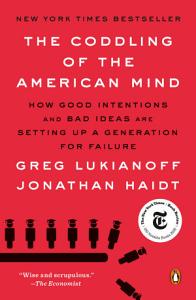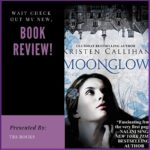Genre: Non-Fiction
Disclaimer: Reading is all about discovery, but this Book Review does not shy away from spoiling specific scenes as this is more of a look inside the good and bad of a book.
The Analysis:
So, I struggled through part 1. Just because I was trying to get my thoughts together on the ideas presented as well as figure out how I was going to review it. Nothing to do with the writing, just a lot going on in my head. I thoroughly enjoyed part 1 as it gave me a lot more to think about it and reconfirmed some things I was already on the road to. At the start, I wasn’t going to review it, and then part 2 happened. Let’s Book Review it.
Here’s the Blurb:
Lukianoff and Haidt investigate the many social trends that have intersected to produce these untruths. They situate the conflicts on campus in the context of America’s rapidly rising political polarization, including a rise in hate crimes and off-campus provocation. They explore changes in childhood including the rise of fearful parenting, the decline of unsupervised play, and the new world of social media that has engulfed teenagers in the last decade

It's a non-fiction cover. I've certainly seen more clever thought-provoking covers. However, this brings the point across that young people are on an assembly line to nowhere. The book was a recommendation so the cover was not why I picked it up.
Now The Story:
Book Info:
Pages: 352
Author: Jonathan Haidt and Greg Lukianoff
Available: Google Play
Books theory: the idea that speech can be violence (even when it does not involve threats, harassment, or calls for violence) spreads because of perceived impact rather than intent.
If I get there meaning, perceived impact = suggested impact and intent = irrationally feeling like somethings always negative.
Hate speech does not equal violence. But hate speech CAN equal violence.
...and I don't think the book does enough to think through this portion of ideology. My book review in a nutshell: Only a short section is given over to conservative views that have contributed to some of the examples depicted in the book. And it's all washed away because conservatives just want you to react, so don't. Or you only feel this way because of the three fallacies, so don't. No sir, I need more than a paragraph to bite this one. And the chapter towards the end doesn't count.
This book review relies on current events just because it's in the forefront of my mind now, but I'm also sure there were plenty of past events that the authors could have referenced for these purposes. The discussion of whether Trump is guilty of January 6 is predicated on hate speech = hate violence. Theoretical nothing he said was intended to be a threat, or call to violence by the logic in the heading. Of course, I think it was as did all the criminals who claimed in their court paperwork to a judge that Trump made them do it.
Recent Asian hate crimes, rooted in hate speech, drummed up by president Trump and far-right media have led some to other a whole community. Now hate crimes are on the rise exponentially. That's a direct correlation between hate speech = hate violence. Of course, if you dig deeper I'm sure the criminals would be willing to offer up other excuses including that their big toe was infected and they were just having a bad day. However, to pick on an Asian American at this time, using certain unflattering language would again suggest hate speech = hate violence.
Frankly, black people can write a dissertation on how many times hate speech has equaled hate violence as could many disenfranchised groups. That they could have referenced even before today's more modern problems.
So maybe young ones are jumping scared now at lecturers in college halls, but wouldn't that just mean that a generation of Gen Z'ers have PTSD. Not that there overreacting in its simplistic form because we wouldn't let them play outside when they were kids.
As a fan of Van Jones, I don't think he's wrong when he's quoted in this book about facing adversity through speech. But I don't think this book made a good case for it.
They also break their own rules of perceived impact rather than intent by comparing The Red Guard to white American college students that they admitted were nonviolent. You cant then accuse them of violence because they are misguided idealists who might stray to far from the middle, that's perceived impact, not judging them on their intent. The example of Evergreen was much closer but they didn't compare that to the Red Guard.
However, I did agree with their breakdown and analysis of the Evergreen situation.
The only thing that came close to answering all these questions for me was a quote by Allison Stanger in part 3. But again the section was so short, I really didn't feel satisfied. The author's answer was what exactly, we're more polarized. Yeah, okay, thanks.
I think the answer is that young people upon learning about centuries of oppression go to college and find themselves more easily burned by campus boiling points. It has nothing to do with new parenting styles or mental health. They've just realized that the needle has moved only a millimeter on racism, sexism, and a plethora of other issues we're still trying to work through in modern times. Their parents and grandparents have indeed fixed nothing. And they might be feeling a tad hopeless in being able to accomplish it themselves. I think the latter part of my statement is referred to in this book (theory name I've already forgotten) being that you have to force equality, by actively resisting anyone who steps out of line. Yeah, it's closer to that.
Funny, how we can say it's crazy. Write a whole book on the destruction of free thought. But we still can't offer up a solution to any of the isms. Which is the only thing I suspect that Generation Z wants.
I'm giving this book a three because like most I feel it has very strong things to say. It even made me rethink my stance on microagressions. I agreed about the let children play. And this world is too complicated to always view things in terms of good and evil. And I do have to credit it for helping me make up my own mind about the changing world that the youth are inheriting.
However, I don't think this book really offers any solutions. They are solutions to the surface problems, but nothing that got to the core of what was causing the rot to begin with. Only because I suspect to do that would be to have the answers to utopia. I also don't think it presents a whole look at the subject matter as it purports to do. I had questions and no answers. But read it. Challenge yourself. Chew up the meat and spit out the bones.
Side note (smaller thematic things):
Other things that caught my eye for this book review: Those that fall on the conservative spectrum on some ideas tend to bring up issues of minimum wage etc., from the perspective of right and left. It's like the U.S. is operating on planet Earth alone. There are no other first-world countries with higher minimum wages, health care for all, and adequate time off for pregnancy thriving for decades from which the U.S. could learn from. (ie., Norway and UK, I salute you.) No, we need more conservative teachers to tell us why the minimum wage hike is bad in order to make a good choice.

I didn't touch on safetyism in my book review, but it's a large part of the book. There is a section on safetyism in relation to child abductions. Basically, everyone's overreacting, and they have statistics to back it up. I don't even have children and I remembered thinking being in that 1% would send any parent to an early grave. It would just hurt so much being the one that miscalculated. Does he have a point? Yes. And I'm glad everything worked out in his parental anecdotal example. But leave this one to the individual parent. Outside of safetyism: a parent's only time to bond with their kid may be during the time to and from school when they walk or drive them. These days kids come with a full calendar schedule of extracurricular activities, homework, part-time job, and family/friends to visit.
Personally, I wouldn't send a child to the store at 6 years old alone just because granny used to be able to buy cigarettes for her dad when she was five, alone, and statistically, crime was worse than. 7th or 8th grade, sure, walk alone. Portions of this discussion get very, old man rocking chair, in my day we used to {insert any number of things} here. There are other ways to explore and let them grow up independently. It also got a tad ridiculous when they included a note to give to your child when they're walking alone and they're stopped by police or a concerned adult. I'm thinking to myself ain't no way people doing this in real life. The book did offer up other examples I agreed with, outside of the walk-alone push that seemed to dominate. I also got tired of reading it all and almost stopped were it not for this book review.
Story At A Glance:
Recommendation: 3 out of 5
Read Series Continuation: N/A
The Ratings:
Book Cover Appeal:
🍓🍓🍓
Story & Narration:
🍓🍓🍓
Romance:
not applicable
Character/(s) Personality:
🍓🍓🍓
Want to leave reality behind, try my book, Ashes and Wine.




